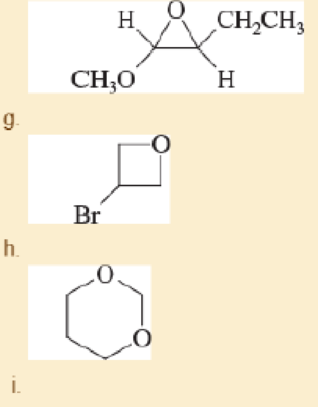
EP ORGANIC CHEMISTRY -MOD.MASTERING 18W
9th Edition
ISBN: 9780136781776
Author: Wade
Publisher: PEARSON CO
expand_more
expand_more
format_list_bulleted
Textbook Question
Chapter 14, Problem 14.31SP
Give IUPAC names for the following compounds.
- a. CH3OCH(CH3)CH2OH
- b. PhOCH2CH3


Expert Solution & Answer
Want to see the full answer?
Check out a sample textbook solution
Students have asked these similar questions
• Whał arc the IUPAC namar of the ff. Carboxylic acias?
a.
COOH
COOH
CH3
b.
I
f.
.COOH
CHJCH2 ÇHCHCOOH
CH3
NO2
tON
C.
COOH
ноос
d.
COOH
Give the IMPAC name for each compound.
1.
COOH
COOH
2.
Br
3. CH3 CHz
COOH
614 Give the IUPAC name for each of the following
5-14
carboxylic acids.
a. CH3-CH2-CH2-CH2-C-OH
CH3 CH3
bilk
b. CH—CH-СН,—С—ОН
CH3 CH3 O
c. CH3-CH-CH-C-OH
CH-CH—С-ОН
d. CH3-CH,—СH,—СООН
Chapter 14 Solutions
EP ORGANIC CHEMISTRY -MOD.MASTERING 18W
Ch. 14.2C - Rank the given solvents in decreasing order of...Ch. 14.2D - Prob. 14.2PCh. 14.2D - In the presence of 18-crown-6, potassium...Ch. 14.3B - Give a common name (when possible) and a...Ch. 14.3C - Prob. 14.5PCh. 14.3C - Name the following heterocyclic ethers.Ch. 14.4 - Propose a fragmentation to account for each...Ch. 14.5 - Prob. 14.8PCh. 14.5 - Prob. 14.9PCh. 14.6 - Prob. 14.10P
Ch. 14.7 - Explain why bimolecular condensation is a poor...Ch. 14.7 - Prob. 14.12PCh. 14.7 - Prob. 14.13PCh. 14.8 - Prob. 14.14PCh. 14.8 - Prob. 14.15PCh. 14.8 - Prob. 14.16PCh. 14.10A - Prob. 14.17PCh. 14.10A - Prob. 14.18PCh. 14.10B - Prob. 14.19PCh. 14.11B - Show how you would accomplish the following...Ch. 14.11B - Prob. 14.21PCh. 14.12 - Prob. 14.22PCh. 14.12 - Prob. 14.23PCh. 14.12 - Prob. 14.24PCh. 14.13 - Prob. 14.25PCh. 14.13 - Prob. 14.26PCh. 14.14 - Prob. 14.27PCh. 14.15 - Give the expected products of the following...Ch. 14 - Write structural formulas for the following...Ch. 14 - Give common names for the following compounds. a....Ch. 14 - Give IUPAC names for the following compounds. a....Ch. 14 - Glycerol (propane-1,2,3-triol) is a viscous syrup...Ch. 14 - Prob. 14.33SPCh. 14 - Show how you would make the following ethers,...Ch. 14 - (A true story.) An inexperienced graduate student...Ch. 14 - Prob. 14.36SPCh. 14 - a. Show how you would synthesize the pure (R)...Ch. 14 - a. Predict the values of m/z and the structures of...Ch. 14 - The following reaction resembles the...Ch. 14 - Prob. 14.40SPCh. 14 - Prob. 14.41SPCh. 14 - Prob. 14.42SPCh. 14 - Give the structures of the intermediates...Ch. 14 - Prob. 14.44SPCh. 14 - Show how you would synthesize the following ethers...Ch. 14 - Prob. 14.46SPCh. 14 - Prob. 14.47SPCh. 14 - Prob. 14.48SPCh. 14 - An acid-catalyzed reaction was carried out using...Ch. 14 - Propylene oxide is a chiral molecule. Hydrolysis...Ch. 14 - Prob. 14.51SPCh. 14 - Prob. 14.52SPCh. 14 - Prob. 14.53SPCh. 14 - Prob. 14.54SPCh. 14 - In 2012, a group led by Professor Masayuki Satake...
Knowledge Booster
Learn more about
Need a deep-dive on the concept behind this application? Look no further. Learn more about this topic, chemistry and related others by exploring similar questions and additional content below.Similar questions
- A. Give the IUPAC name for the following compounds. OH NH2 OCH2CH2CH3 CIarrow_forwardWhat is the IUPAC name for each of the following compounds? a.C6H5CH2(CH2)3COOH b. Br(CH₂)3COOH D-CH. C.arrow_forwardInstructions: Draw out each compound to clearly show what groups are bonded to the carbonyl carbon. Label each compound as a carboxylic acid, ester, or amide. a. CH3CH2CO2CH2CH3 b. CH3CONHCH3 c. (CH3)3CCO2H d. (CH3)2CHCON(CH3)2 Instructions: Give the IUPAC name for each compound. A. CH₂ CH₂CH₂CH₂CCH₂COOH CH3 B. CH₂CHCH₂CH₂COOH CH₂COOH CH₂CH3 C. (CH,CH,),CHCH,CHCOOH Instructions: Give the structure corresponding to each IUPAC name. a. 2-bromobutanoic acid b. 2,3-dimethylpentanoic acid c. 2-ethyl-5,5-dimethyloctanoic acid d. 3,4,5,6-tetraethyldecanoic acidarrow_forward
- 9. Assign an IUPAC name to each of the following compounds. 2. a. CH3-C-O-C-CH2-CH, b. CH3-CH2-CH-CH-C-CI L. C. CH3-CH-CH-C-Cl ČH3 CH3 d. CH3-CH-C-0-C-H Draw the structures of the esters formed by reacting the following substances 1 molecule methanol and 1 molecule phosphoric acid 2 molecules methanol and 1 molecule phosphoric acid 1 molecule methanol and 1 molecule nitric acid 1 molecule ethylene glycol and 2 molecules of nitric acid 0. A. В. C, D.arrow_forward1. Give the IUPAC name for the following compounds. CH3 a. b. с. Pharrow_forwardH3C. H3C CH3 Br 1-propanolarrow_forward
- 1. WRITE THE IUPAC NAME OF THIS ETHER CH3CH2-O-CH2CH2CH2CH2CH3 2. HOW DO PHENOLS DIFFER FROM ALCOHOLS IN TERMS OF STRUCTURE AND PROPERTIES? 3. HOW DO PHENOLS DEIFFER IN PROPERTIES FROM AROMATIC HYDROCARBONS?arrow_forwardGive the IUPAC name for each compound. CH3 CH2CH3 Br a. PHCH(CH3)2 b. С. d.arrow_forwardProvide the IUPAC names for the following compounds. Compound IUPAC Name 1. H3Ç CH3 H2C=CHCHCCH3 CHa 2. CH3 CH3CH2CH=CH2CH3 3. CH3 CH3CH=CHCHCH=CHCHCH3 CH3 4. CH3CHCH2CH3 CH3CH2CH2CH=CHCHCH2CH3 5. „CH3 CH3arrow_forward
- What is the IUPAC name for the following? O isobutyl benzoic acid Oisobutyl benzoate sec.butyl benzoic acid sec.butyl benzoester sec.butyl benzoate 0 II COCHCH₂CH3 CH3arrow_forwardGive the IUPAC name for each compound. OH a. CH3CH(CH₂)4CH3 (select) OH (CH3CH₂)2CHCHCH₂CH3 (select) b. C. d. CH3 OH (select) (select) (select) OH (select) (select) (select)arrow_forwardThe correct IUPAC name for this compound is: O a. 4-oxa-1-cyclohexanol O b. 4-hydroxyoxacyclohexene O c. 4-oxa-1-cyclohexenol O d. 4-oxacyclohexane-1-ol OHarrow_forward
arrow_back_ios
SEE MORE QUESTIONS
arrow_forward_ios
Recommended textbooks for you
 Chemistry for Today: General, Organic, and Bioche...ChemistryISBN:9781305960060Author:Spencer L. Seager, Michael R. Slabaugh, Maren S. HansenPublisher:Cengage Learning
Chemistry for Today: General, Organic, and Bioche...ChemistryISBN:9781305960060Author:Spencer L. Seager, Michael R. Slabaugh, Maren S. HansenPublisher:Cengage Learning

Chemistry for Today: General, Organic, and Bioche...
Chemistry
ISBN:9781305960060
Author:Spencer L. Seager, Michael R. Slabaugh, Maren S. Hansen
Publisher:Cengage Learning
07 Physical Properties of Organic Compounds; Author: Mindset;https://www.youtube.com/watch?v=UjlSgwq4w6U;License: Standard YouTube License, CC-BY